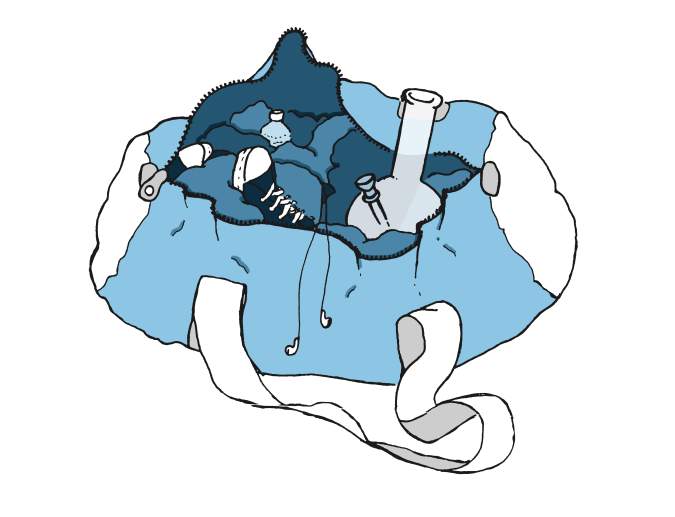Uncategorized
The Pax 2 Review
PAX 2 Review
Michael A. Stusser
INTRO TO VAPES
First things first: There are people who like to smoke out of bongs. There are people who prefer to roll a fatty. (That’s me!) There are fans of the one-hitter, glass pipe aficionados, Roor rooters, boisterous bubblers, glass-beaker geekers, hookah-suckas, and everything in between (i.e. partially crushed aluminum cans, pineapple pipes, etc.). And it’s all good. However you want to get high is your business – so long as you share.
One of the more modern conventions for getting baked is through the use of a vaporizer….Vapes allow the user to inhale “vapor” – and not smoke. Instead of the cannabis being combusted (by match or Zippo or blowtorch) – the vaporizer brings your marijuana flower (or oil or hash) to a temperature that’s hot enough to sublimate cannabinoids in cannabis, but doesn’t actually combust the herb. Sort of like a convection oven instead of a raging BBQ…but hand-held. In addition to it being an excellent option for individuals wanting to eliminate the various risks of smoke inhalation (a good choice for MMJ patients wanting the benefits of cannabinoids and terpenes, but not the potential lung irritations from smoke inhalation), vaporizing marijuana creates a more effective release of the medicinal properties of the cannabis flower.
THE PAX
Known as “The iPhone of Vaporizers,” the Pax brand has been around since 2012 (previously Ploom, now Pax Labs Inc.), and the product reviewed here is their second – and highly improved edition. I experimented with the original Pax a few years back (which sold over 500,000 units), but why waste time on the iPhone 4S- when there’s a new version of the iPhone 9 to discuss?
The new re-designed Pax is available in four color choices, all made from a hip and durable, transverse-brushed aluminum (the same anodized shell the iPhone 6 is forged out of). The iconic Pax looks like a minimalist high-end, high-tech product you’ll be proud to be seen carrying around. (Let’s be real – if you’re paying top dollar for a glorified pipe – around $280 – it better be sexy as hell. And this is.)
The new Pax 2 is 25% smaller and ten percent lighter than the original, and instead of a retracting mouthpiece, has a groovy flap of sorts that, according to the manufacturer, uses “lip-sensing technology.” (I wish my girlfriend did!) A second rubber mouthpiece that extends slightly from the top is also included. The Stanford University geeks who created the Pax brand have done a great job of combining applied science principles, technology, and a very cool (and stolen from Apple) design – to wind up with a unique and quality product that does not disappoint.
While there are a plethora of settings available for the Pax, for folks like me who like to “dumb it down,” the elegant product is also extremely easy to use. Press…wait, and in less than a minute, when the iconic LED Pax logo goes from pulsing purple flickering glow to a solid neon green, begin to suck. When you’re done, click the top mouthpiece down to turn it off, and re-load!
The heating element in the Pax can be set to four various heat settings, and has an intelligent cooling down system as well. While I’ve had the unit for several months, I rarely cycle through to choose a particular heating level, but instead let the smart machine do it’s thing.
Unlike many vaporizers with temp control, the smartest part about PAX is that it measures the temp of the herb…not the stainless steel oven itself. So instead of the chamber burning away, the PAX makes sure you’re cooking your prime ganja all the way through. (If you’re spending serious money on a vape, you better also be putting some cool cash into the best weed out there…)
There’s a distinct and almost sweet smell that my Pax emits when the ganja is ready – and the clovers glow green. It’s not so much that anyone would be able to call out the stank of cannabis – it’s almost like a bagel’s ready. Once you exhale from the Pax, or course, there is vapor (looks like smoke to me, but all the vaporizers gotta vape something…and it’s more than just heat), and the smell of marijuana. Given that I’m in a legal state (and don’t mind breaking the public consumption of cannabis laws) – the sweet smell actually makes me proud to share with my fellow citizens.
The newest Pax is also designed with various built-in sensors (it’s not a Tesla, but close!). The sensors include an accelerometer to put the device to sleep when it’s been set down, and the battery level which can be checked when the user shakes the Pax. (The four clover leaves show the various levels of charge remaining.) It’s also just fun to rotate the device in your hand three times to show your friends the spinning, colorful Pax clover in Party Mode. (Seriously. It’s beautiful.) Apparently there are also various “secret” games…though I had difficulty figuring them out, especially after taking several draws off the machine. (I even got sent a special detailed PDF from PAX public-relations on each and every user-interface and indicator, and I STILL don’t understand what the fuck’s going on.)
Until you take the Pax out for a test drive – outside your home – you really don’t get the coolness factor of the product. I’ve had the unit for 2 months, but it sat next to my gorgeous double-bubbler art-glass PDX bong, which is quick and powerful and easy to use. (No battery required.) So the PAX just sat there, looking like a slick modern remote control next to my weed box and bong. And then it hit me. Portable. Oh yeah. PORTable! So I packed it tight (as the manual suggests) and hit the bars. So cool. People love it! And when you whip out your Pax, you’re the hit (literally) of any party.
Could this sleek, gorgeous gizmo be better engineered? Probably. It needs a deeper chamber. WAY Deeper. Even though it’s larger and wider than the original version, the current “bowl” is only big enough to pack about 7-10 real “hits” in one go-round. While that’s enough for a few people to get nicely baked, it’s then necessary to knock out the roasted and toasted ganja, and repack a re-fill. As with all vaporizers – is a bit of a to-do. (The bottom sub-flush lid comes off simply enough – and is held in place with two powerful neodymium magnets.) It should also be noted the chamber for weed is consistent with other high end vaporizers…so it could be me that needs to cut down and get a grip on this gripe. Similar to a bong or pipe, a bowl can only be so large for maximum freshness and use before it needs to be refilled – so my complaint may simply be a factor of my own need for moderation.
The only other tweak I’d make on the next version (Pax 3!) is the shape. Given our digital obsession (and societal one at large, now that I think of it) – it’s true the Pax could be more iPhone-shaped: Skinner, longer, and with a slight arc to fit along your skinny thigh. But the current heft is fantastic – it’s got a perfect weight in the palm, and that glowing psychedelic clover is just the fucking coolest thing ever.
The Pax uses a USB-charger (similar to Apple’s Mag-Safe units) that powers up a lithium ion battery, and – as tested – lasts for over 3 hours per charge (90 minutes to charge, on average), which is more than you’ll need. The unit turns itself off if you don’t draw on the mouthpiece or touch in for three minutes (and goes into standby mode by slowly lowering the temp after only 20 seconds) – so you’ve actually got five or six hours of party time before the battery truly runs out.
By far the best feature of the Pax is that it’s stealthy – not because of it’s actual size (which is really the smallest/most compact of the high-end vaporizers on the market) – but because even when I bring the thing out in broad daylight – at football games or bars or concerts or cafes – people see me handling this odd-looking graphite device that has a pulsing light and can’t fathom it’s a cannabis vaporizer. They’re more likely to think I’m holding a digital tape recorder up to my mouth than a machine that allows me to smoke (vape? cook?) marijuana! It’s so elegant, I often set mine on the table in cocktail lounges (sadly, next to my fawking iPhone) and see if anyone reacts. It’s rare. Mostly (sadly) they’re lost in their own digital devices, and not paying any attention.
In the end, how do I know I like it the Pax? Because it’s in my pocket every time I leave the house.
https://www.paxvapor.com/pax-2/
The Pax 2 runs around $280 and includes a 10 year warranty.
Available in charcoal (black), topaz (aqua), flare (red) and platinum (silver).
DEVICE DIMENSIONS
3.87 x 1.21 x 0.85
OVEN DIMENSIONS
18.5mm x 8.6mm x 10mm
BATTERY
Lithium-ion battery recharges in 2-3 hours via USB or AC wall adaptor
HEATING ELEMENT
Thin film Kapton heater flex
INTERNAL ACCELEROMETER
Detects motion to put PAX in standby-mode when not in use to conserve battery life and oven contents
MATERIALS
Vapor path is constructed entirely from medical grade components. All plastic components are food-safe engineering plastics of the highest quality available.
IN THE BOX
Included in the box are:
•The PAX 2
•Two silicone mouthpieces—a flat one, flush with the top of the
device, and one raised option
•One magnetic charging cradle with USB cord
•PAX 2 cleaning kit with isopropyl alcohol & pipe cleaners
Higher Ground: Runner’s High
Spring has sprung, and it’s finally time to strap on the running shoes and get stoned out of your mind!
There’s no doubt that marijuana is good for all kinds of things: stimulating the appetite, creative brainstorming, giggle-fests . . . but exercise? Yes, apparently. According to an article in last month’s Runner’s World, athletes who use cannabis benefit from stress relief and reduced inflammation.
Now I’m no marathoner, but I do understand the pain and nausea that kind of grind might cause; hell, I “hit the wall” on walks from Starbucks to the car. And long-distance runners are now claiming that the pain relief associated with marijuana is also a huge benefit for their grueling efforts, helping athletes achieve an idealized state earlier in their run.
“When you have runner’s high, you have feelings very similar to those you would feel if you were smoking marijuana,” stated neuroscientist Arne Dietrich in Runner’s World. The prefrontal cortex of the brain regulates both feelings, Dietrich notes, including “sedation, analgesia, mild happiness, the loss of the sensation of time, and a loss of worries.” What? Where was I?
It makes sense that the CBDs that help to block the input of pain for medicinal purposes and act as anti-inflammatories can also help athletes struggling with joint pain in various sports. And we’re not just talking about snowboarders or Ultimate Frisbee Golf jocks either. A Wall Street Journal story recently interviewed ultra-marathon runners, who run up to 200 miles over 20-hour periods, and many noted that cannabis aids with the stomach cramps and intense muscle pain they endure along the way. “The person who is going to win an ultra is someone who can manage their pain, not puke, and stay calm,” said veteran runner Jenn Shelton. “Pot does all three of those things.” I have a better suggestion for these masochistic ultra-marathoners: moderation!
Even the World Anti-Doping Agency and U.S. Track & Field are coming around on dope. Last year the WADA raised the acceptable amount of THC a runner can have in his or her system, flagging only runners who use pot on the day of competition. Using marijuana during training sessions or as a sleep aid the night before a race is all good. There’s a reason the fastest man on the planet, Usain Bolt, is from Jamaica, mon!
Running high as a kite is not for everyone. Chronic smoking has been related to pulmonary irritation and symptoms of chronic bronchitis (including hocking loogies). “There are cardiovascular effects, like increasing heart rate,” says Gregory Gerdeman (The Pot Book) in the Runner’s World piece. “These may be minimal in young athletes or those with tolerance, but should be considered seriously by anyone at risk for coronary heart disease. Plus, there have been some studies that suggest it influences blood flow to the brain, which can influence the risk of stroke.”
Still, cannabis smoking doesn’t have nearly the negative effect on the lungs that tobacco does. The National Institutes of Health did a study in 2013 that I wish I’d been chosen for. They exposed a group of adults to up to seven “joint years”—one joint per day for seven years—and found that even those extremes didn’t diminish lung function. In fact, marijuana users in the study performed a little better than nonsmokers on a lung-function test, because ganja smokers were basically “training” over time by taking deep breaths and holding smoke in.
Outside did its own piece on stoned running (“Know Before You Go!”), and, while not condoning the practice, gave helpful tips, including not getting lost, bringing munchies along the way, and “dosing” in a safe environment: “You don’t want to be 10 miles into the mountains and suddenly feel like you need to take a nap because THC makes you sleepy, then find yourself dozing off in the middle of the woods with no food or shelter.” Their advice on dosing was a little . . . high: “While lower doses often lead to a relaxed physical state and sense of well-being, or a ‘body high,’ high doses can bring on an acid-trip type of experience with hallucinations and possible paranoia. Once the drug kicks in, the high can last from four to 10 hours, or possibly longer.” Not sure where they’re getting their ganja, but I want some. Wow!
My own advice is to use marijuana as a sort of reward after you exercise. The perfect indulgent treat? The CannaBar! It’s a protein candy bar made using almonds, honey, and hemp-based cannabidiols—with less fatty ingredients that the Clif bars you’re shakily shoving in mid-marathon. Sadly, the CannaBar is made with a cannabis sativa without much THC, so it doesn’t get you high; you’ll want to do that in the traditional way—and by that I mean taking off your Brooks, collapsing on the couch, and sucking down bong hits.
This article first appeared in the Seattle Weekly.
Higher Ground: Pot for Pets
Can weed give our furry companions happier lives and more peaceful deaths?
Remember the right-wing homophobes who claimed that if we allowed gays to get married, pretty soon people would begin marrying their pets? Well, now, the damn hippies who voted to legalize the wacky weed are indeed trying to get their dogs and cats stoned! Hooked on the hound hemp! The kitty chronic!?
Companies like Seattle-based Canna-Pet and Canna Companion sell cannabinoid treats for dogs and cats—not to get them high (the hemp biscuits and capsules have very low levels of THC), but to help with joint discomfort and inflammation, and hopefully to make that yappy poodle across the street calm the fuck down.
Recently the Food and Drug Administration began cracking down on pooch-pot peddlers for some of the claims made in their marketing materials. The FDA wants phrases like “anti-cancer” and “anti-tumor” taken off Canna-Pet’s packaging, as those medical claims have not been proven.
Canna Companion, from Snohomish County, says their products are all-natural, and inhibit cancer-cell growth and reduce inflammation. Clinical trials monitored by the FDA haven’t taken place, because of course at the federal level, the testing or sale of marijuana is a felony offense—not to mention it’s hard to get Fido to fill out the post-trial questionnaire. Cats are better at giving feedback, but are prone to hissy fits in the comments section.
Similar to humans, domesticated animals have endocannabinoid systems and can potentially be physically and psychologically aided by ingesting cannabis. While industrial hemp hasn’t been proven as a puppy painkiller, many vets and owners have had success using the stuff to help pets gain weight after sicknesses and surgery, as well as to provide pain relief during end-of-life stages. Los Angeles veterinarian Doug Kramer told the Associated Press that he’s had more than 300 patients use cannabis to help everything from infections to separation anxiety to feline immunodeficiency virus to irritable-bowel syndrome (which I thought was the very definition of being a pet). Talk about skunk weed!
After giving his husky, Nikita, cannabis oils for her terminal cancer, Dr. Kramer said she gained weight and was able to live an extra six pain-free weeks before having to be euthanized. “I grew tired of euthanizing pets when I wasn’t doing everything I could to make their lives better,” Kramer noted. “I felt like I was letting them down.”
Things are going a bit too far in Nevada, where, as part of a bill to overhaul their medical-marijuana laws, state Senator Tick Segerblom proposed a Pot-for-Pets provision that would require animal owners to apply for medical-marijuana cards. Cards would be issued only if a vet wrote a detailed description of how Count Flufferton’s condition might be aided with Puppy Chow Dank. Good Lord, it’s hard enough for folks to clean up after their pets, much less register them for a Canine Cannabis Card. Feed ’em all the Purina Cheeba ya want, as far as I’m concerned—just pick up the poop!
Veterinarians agree that feeding a pet straight marijuana or blowing pot smoke in Mr. Bigglesworth’s snout is never a good idea; most companies marketing for pets are using all-natural hemp treats, cannabis oils, and glycerin tinctures that can be put into the water bowl.
Not surprisingly, People for the Ethical Treatment of Animals has something to say on the matter. “Our position is that anything that can help animals,” stated President Ingrid Newkirk, “if it’s truly, properly administered in the right amount and can relieve a dog’s pain—then they should be given the same consideration that humans in pain are given.” (No comment on whether PETA gives ganja to the tens of thousands of pets they euthanize at their shelters after not finding homes for the non-rescued souls . . . )
While weed’s not a cure-all for everything; it’s also not gonna kill you (or your chronic companion). My neighbor’s golden retriever, Bailey, not only drank half a gallon of paint I had (stupidly) left out one summer day, but also chowed the brush and sponge inside it. She hurled a lovely shade of Benjamin Moore chartreuse-green for a week, but went on to live—and crap in my yard—for another decade. The bottom line is this: I don’t care if Snoopy gets high as the Red Baron on Snoop Dog Bud-Bones, just keep that pooch away from my personal stash. The steak’s for me. Lassie gets the leftovers.
This article first appeared in the Seattle Weekly.
Higher Ground: The Stusser Omnibus Marijuana Bill
A modest proposal to head off the awful Senate Bill 5052.
Last week, three U.S. senators introduced a bill that attempts to amend many of the outdated medical-marijuana conundrums at the federal level. The bill would end the prohibition of medical marijuana, reclassify the plant from its current designation as a Schedule 1 narcotic (a status that suggests no medical value and high potential for abuse), and allow for more cannabis study and research. While the bipartisan bill doesn’t have a snowball’s chance in hell of passing, it’s a great conversation starter.
Inspired by those ballsy senators—and in fear of the awful Senate Bill 5052 that is currently wending its way through Olympia—I’ve decided to take my own shot at solving Washington state’s own clusterfuck. So without further ado, I present the framework of my own Omnibus Marijuana Bill.
Let my people grow! I mean, really. Every other state that’s legalized marijuana has allowed citizens to grow for personal use, and we should too. It’s a no-brainer. Put a limit on the number of plants per person (six per adult, perhaps, or higher if used for medicinal purposes), and, like tomatoes and snap peas, allow folks to play in the garden. (Probably not a great plant for community pea patches, but fab for collective gardens for medical patients, many of whom are too sick to tend to the crop themselves.)
Regulate medical dispensaries. The state estimates that there are more than 1,000 dispensaries, operating all willy-nilly. While many are clearly fly-by-night operations that don’t check ID, a good number have been instrumental for decades in helping the medical community find strains and products and oils that help patients. So it just makes sense that any longstanding, established dispensary should be allowed to continue operating. Hell, I’ll pick a random number that can be allowed: 420.
No medical registry. The bill from Republican Sen. Ann Rivers that the state Senate just passed calls for the creation of a statewide registry for medical patients. Puh-lease. Patients don’t fear putting their names on the dotted line because they’re faking their illnesses to get cheaper weed, but because admitting to a felony at the federal level is a pretty bad idea. Patients can lose their jobs and have their children taken for this kind of admission. No registry.
Whack the taxes. Right now there’s a triple-decker tax structure in place: Recreational weed is hit with a 25 percent tax when it moves from farmer to processor, then again from processor to retailer, and again to the end customer. Pretty much everyone agrees a single tax is the best idea here—so pick a single sin-tax percentage and go with it. Too high, though, and I’m staying with my dealer.
Medical cards. Any patient with a qualified doctor who recommends (not prescribes) marijuana to alleviate suffering for terminal or debilitating conditions such as cancer, epilepsy, PTSD, and chronic pain should be allowed to purchase it tax-free at licensed medical dispensaries, just as citizens across the country (except Illinois) can receive their tax-free prescriptions for Ambien, Valium, Prozac, and whatever that purple pill is.
Free hemp now. My Omnibus Marijuana Bill is so comprehensive that I plan to roll hemp legislation into it, thus killing two buzzed birds with one stone: Legalize hemp for farming, commerce, and production, and just ignore the absurd bans on industrial hemp. Don’t be silly; the fibrous stuff doesn’t even get ya high.
Rec stores must stock medicinal products. Most of the individuals working to bring cannabis out of the shadows and into the legal mainstream were from the medical community—and riskily toiling long before the greedy Green Rush Potrepreneurs got in line for a Weed Lotto Ticket to make marijuana moolah. The least these green-lit licensees can do is stock their shelves with a small percentage of medicinal items in their inventory.
No pot, no pay. Cities and counties that ban marijuana outlets—either recreational or medical—will get absolutely no tax revenue from sales of marijuana. Period. In addition, as they are restricting both the will of the people and access for medical patients who may not be able to drive to places that do allow marijuana sales, these cities must build a FastTrack Elevated Electric Train system for their residents to travel from their homes to the nearest marijuana-friendly city.
Let’s get loungey! Pot lounges and cafes where adults can smoke marijuana are a safe and social way for folks to get fired up. Hell, even the Seattle City Attorney likes the idea. Allow for cigar lounges and smoky pool halls too! You don’t like ’em? Don’t patronize ’em! We’re not looking to be Amsterdam with a cannabis cafe on every corner—though if Howard Schultz wants to get into the franchise game, Starbuds is a damn fine name. Probably shouldn’t allow alcohol in cannabis clubs however; people get crazy on that shit.
This article first appeared in the Seattle Weekly.
Higher Ground: Weed in the Rose Garden
The legalization battle arrives at our nation’s capital.
Every single day there’s breaking news in the marijuana movement. Alaska officially legalized weed on February 24, making it the fourth state in the Union to toss aside the chains of prohibition, and the next day, at the stroke of midnight, our nation’s capital, Washington, D.C., followed suit. #CommanderInSpleef! 
But if ya think the “Just Say No” Nancy Reagan types are gently stepping aside, and the taxation and regulation of cannabis are going along swimmingly, you’ve been smoking too much of the recently legalized chronic.
In the District of Columbia, an hour before the city officially made recreational ganja legal, Republicans in the House of Representatives tossed a little fear-mongering into the mix.
“You can go to prison for this,” Rep. Jason Chaffetz (R-Utah) told The Washington Post—and the citizens of D.C. who overwhelmingly approved the initiative. ”We’re not playing a little game here.”
Reps. Chaffetz and Mark Meadows (R-N.C.) sent a memorandum to D.C. Mayor Muriel Bowser, threatening that if the city chose to move forward with pot in the District, “you will be doing so in knowing and willful violation of the law.” The right-wing reps were trying to nullify legalization—and the will of the people—through riders they’d previously attached to the unrelated trillion-dollar Congressional spending bill.
The letter went on to demand that Bowser create a list of all D.C. employees who participated in the enactment of the ballot measure, fork over their timecards, and share their salaries, apparently in an effort to create a sort of Green List. Joe McCarthy would be so proud.
Bowser’s no pushover (hell, in D.C., mayors often smoke crack just to deal with the toughness of their constituents); she let the world know she would do what more than 70 percent of her residents made clear they wanted when they passed the measure last summer. “My Administration is committed to upholding the will of DC voters,” she tweeted. “We will implement Initiative 71 in a thoughtful, responsible way.”
Police Chief Cathy Lanier is also on board, telling the American News Women’s Club, ”All those [marijuana]arrests do is make people hate us.” She added, “Marijuana smokers are not going to attack and kill a cop. They just want to get a bag of chips and relax. Alcohol is a much bigger problem.”
D.C.’s decriminalization law is a particularly big deal because of the massive racial biases behind marijuana arrests in the city. According to the Washington Lawyers’ Committee for Civil Rights and Urban Affairs, nine out of 10 people arrested for drug offenses in D.C. between 2009 and 2012 were black. And while blacks make up slightly more than half of the city’s population, surveys show they’re no more likely than whites to use marijuana. The craziest fact of all, according to The Washington Post: White folks are more likely than any other race to be selling drugs. Let’s just say it loud and clear: The War on Drugs is a war on black Americans.
Beyond that, the new D.C. law is largely symbolic, as sales of any kind are not allowed (which also means they won’t be collecting any of those sweet tax dollars). Individuals are allowed to possess and cultivate up to six plants, but only three can be budding in the government’s backyard at a time. District residents can’t fire up on federal land (yes, that means the Lincoln Memorial), in bars or restaurants, or in public housing. Medical marijuana is allowed (it was passed in D.C. in 2010), and if you’re feeling particularly generous, you can “gift” an ounce to friends, family, and fellow residents, so long as they’re over 21. (“Mr. Speaker, I hereby offer this peace-doobie to break the gridlock . . . ”)
The road to national legalization will be paved with setbacks, scare tactics, and a social conversation about what it means to be high. As with moonshine, civil rights, and same-sex marriage, we’ll have to tinker a bit to get it right. Nebraska and Oklahoma are taking Colorado to the U.S. Supreme Court, claiming legalization is causing massive drug-enforcement problems, with too many pickups full of Denver ganja entering their backyards. Last week all nine former DEA heads joined the brief. It points to red state/blue state differences, and serves as yet another reminder that, yes, marijuana is still illegal at the federal level.
But in a sign that we can all get along, a man walked into the Sixth District police station in D.C. last Monday and asked for his previously seized weed back. (He’d been arrested for a charge unrelated to drugs, and, along with a belt and a wallet, had his stash taken during processing.) As possession of two ounces or less is fully legal, an officer gave him his baggie of marijuana. Progress, apparently, comes in small doses.
This article first appeared in The Seattle Weekly.
The Cheryl Shuman Interview
Our interview with CEO Cheryl Shuman covers everything from how to get a membership in the Beverly Hills Cannabis Club, to the de-scheduling of marijuana and one-too-many-Selfies.








